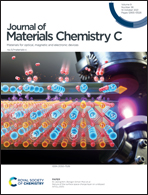Synthesis of colloidal MnAsxSb1−x nanoparticles: compositional inhomogeneity and magnetic consequences†
Abstract
The ternary manganese pnictide phases, MnAs1−xSbx, are of interest for magnetic refrigeration and waste heat recovery due to their magnetocaloric properties, maximized at the Curie temperature (TC), which varies from 580–240 K, depending on composition. Nanoparticles potentially enable application in microelectronics (cooling) or graded composites that can operate over a wide temperature range, but manganese pnictides are synthetically challenging to realize as discrete nanoparticles and their fundamental magnetic properties have not been extensively studied. Accordingly, colloidal synthesis methods were employed to target discrete MnAsxSb1−x nanoparticles (x = 0.1–0.9) by arrested precipitation reactions of Mn2(CO)10 with (C6H5)3As![[double bond, length as m-dash]](https://www.rsc.org/images/entities/char_e001.gif) O and (C6H5)3Sb in coordinating solvents. The MnAsxSb1−x particles are spherical in morphology with average diameters 10–13 nm (standard deviations <20% based on transmission electron microscopy analysis). X-Ray fluorescence spectroscopy measurements on ensembles showed that all phases had an excess of Sb relative to the targeted composition, whereas energy dispersive spectroscopic mapping data of single particles revealed that the nanoparticles are inhomogeneous, adopting a core–shell structure, with the amorphous shell rich in Mn and O (and sometimes Sb) while the crystalline core is rich in Mn, As, and Sb. Magnetization measurements of the nanoparticle ensemble demonstrated the presence of both ferromagnetic and paramagnetic phases. By combining the magnetization measurements with precision chemical mapping and simple modeling, we were able to unambiguously attribute ferromagnetism to the MnAsxSb1−x crystalline core, whereas paramagnetism was attributed to the amorphous shell. Magnetization measurements at variable temperatures were used to determine the superparamagnetic transition of the nanoparticles, although for some compositions and particle sizes the blocking temperature exceeded room temperature. Preliminary magnetic studies also revealed a conventional dependence between core size and coercivity, in spite of variable compositions of the nanoparticles, an unexpected result.
O and (C6H5)3Sb in coordinating solvents. The MnAsxSb1−x particles are spherical in morphology with average diameters 10–13 nm (standard deviations <20% based on transmission electron microscopy analysis). X-Ray fluorescence spectroscopy measurements on ensembles showed that all phases had an excess of Sb relative to the targeted composition, whereas energy dispersive spectroscopic mapping data of single particles revealed that the nanoparticles are inhomogeneous, adopting a core–shell structure, with the amorphous shell rich in Mn and O (and sometimes Sb) while the crystalline core is rich in Mn, As, and Sb. Magnetization measurements of the nanoparticle ensemble demonstrated the presence of both ferromagnetic and paramagnetic phases. By combining the magnetization measurements with precision chemical mapping and simple modeling, we were able to unambiguously attribute ferromagnetism to the MnAsxSb1−x crystalline core, whereas paramagnetism was attributed to the amorphous shell. Magnetization measurements at variable temperatures were used to determine the superparamagnetic transition of the nanoparticles, although for some compositions and particle sizes the blocking temperature exceeded room temperature. Preliminary magnetic studies also revealed a conventional dependence between core size and coercivity, in spite of variable compositions of the nanoparticles, an unexpected result.



 Please wait while we load your content...
Please wait while we load your content...